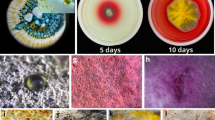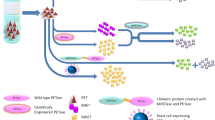Abstract
Indirubin is a strong inhibitor of several eukaryotic cell signaling pathways and shows promise as a treatment for myelocytic leukemia and Alzheimer’s disease. The tmoABCDEF operon, encoding the components of a novel toluene 4-monooxygenase from the paint factory soil isolate, Pseudomonas sp. M4, was cloned and expressed in Escherichia coli. E. coli::pKSR12 expressing the tmo genes was used to develop a two-phase [dioctyl phthalate (DOP)/aqueous medium] culture system that was optimized to obtain maximal yields of indirubin from the starting substrate, indole. DOP was used as the organic phase to solubilize and sequester the toxic indole substrate, making possible the use of high indole concentrations that would otherwise interfere with growth in aqueous media. A 50 % (v/v) DOP two-phase system using tryptophan medium containing 3 mM cysteine, 5 mM indole, and 1 mM isatin yielded 102.4 mg/L of indirubin with no conversion of indole to the less valuable alternate product, indigo.



Similar content being viewed by others
References
Nam, S., Buettner, R., Kim, D., Cheng, J. Q., Turkson, J., Muehlbeyer, S., et al. (2005). Indirubin derivatives inhibit Stat3 signaling and induce apoptosis in human cancer cells. Proceedings of the National Academy of Sciences of the United States of America, 102, 5998–6003.
Polychronopoulos, P., Magiatis, P., Skaltsounis, A. L., Myrianthopoulos, V., Mikros, E., Tarricone, A., et al. (2004). Structural basis for the synthesis of indirubins as potent and selective inhibitors of glycogen synthase kinase-3 and cyclin-dependent kinases. Journal of Medicinal Chemistry, 47, 935–946.
Leclerc, S., Garnier, M., Hoessel, R., Marko, D., Bibb, J. A., Snyder, G. L., et al. (2001). Indirubins inhibit glycogen synthase kinase-3β and CDK5/P25, two protein kinases involved in abnormal tau phosphorylation in Alzheimer’s disease: A property common to most cyclin-dependent hinase inhibitors. Journal of Biological Chemistry, 276, 251–260.
Singh, A., Chauhan, N. S., Thulasiram, H. V., Taneja, V., & Sharma, R. (2010). Identification of two flavin monooxygenases from an effluent treatment plant sludge metagenomic library. Bioresource Technology, 101, 8481–8484.
O’Connor, K. E., Dobson, A. D., & Hartmans, S. (1997). Indigo formation by microorganisms expressing styrene monooxygenase activity. Applied and Environmental Microbiology, 63, 4287–4291.
Yen, K. M., Karl, M. R., Blatt, L. M., Simon, M. J., Winter, R. B., Fausset, P. R., et al. (1991). Cloning and characterization of a Pseudomonas mendocina KR1 gene cluster encoding toluene-4-monooxygenase. Journal of Bacteriology, 173, 5315–5327.
Bertoni, G., Bolognese, F., Galli, E., & Barbieri, P. (1996). Cloning of the genes for and characterization of the early stages of toluene and o-xylene catabolism in Pseudomonas stutzeri OX1. Applied and Environmental Microbiology, 62, 3704–3711.
Kim, J. Y., Lee, K., Kim, Y., & Kim, C. K. (2003). Production of dyestuffs from indole derivatives by naphthalene dioxygenase and toluene dioxygenase. Letters in Applied Microbiology, 36, 343–348.
Oppenheim, S., Studts, J., Fox, B., & Dordick, J. (2001). Aromatic hydroxylation catalyzed by toluene 4-monooxygenase in organic solvent/aqueous buffer mixtures. Applied Biochemistry and Biotechnology, 90, 187–197.
McClay, K., Boss, C., Keresztes, I., & Steffan, R. J. (2005). Mutations of toluene-4- monooxygenase that alter regiospecificity of indole oxidation and lead to production of novel indigoid pigments. Applied and Environmental Microbiology, 71, 5476–5483.
Doukyu, N., Toyoda, K., & Aono, R. (2003). Indigo production by Escherichia coli carrying the phenol hydroxylase gene from Acinetobacter sp. strain ST-550 in a water–organic solvent two-phase system. Applied Microbiology and Biotechnology, 60, 720–725.
Shi, S., Ma, F., Sun, T., Li, A., Zhou, J., & Qu, Y. (2013). Biotransformation of indole to indigo by the whole cells of phenol hydroxylase engineered strain in biphasic systems. Applied Biochemistry and Biotechnology, 169, 1088–1097.
Tao, Y., Bentley, W., & Wood, T. (2005). Phenol and 2-naphthol production by toluene 4-monooxygenases using an aqueous/dioctyl phthalate system. Applied Microbiology and Biotechnology, 68, 614–621.
Chen, J., Banks, D., Jarret, R. L., Chang, C. J., & Smith, B. J. (2000). Use of 16S rDNA sequences as signature characters to identify Xylella fastidiosa. Current Microbiology, 40, 29–33.
Rui, L., Reardon, K., & Wood, T. (2005). Protein engineering of toluene ortho-monooxygenase of Burkholderia cepacia G4 for regiospecific hydroxylation of indole to form various indigoid compounds. Applied Microbiology and Biotechnology, 66, 422–429.
Meyer, A., Würsten, M., Schmid, A., Kohler, H.-P. E., & Witholt, B. (2002). Hydroxylation of indole by laboratory-evolved 2-Hydroxybiphenyl 3-Monooxygenase. Journal of Biological Chemistry, 277, 34161–34167.
Ramos-González, M.-I., Olson, M., Gatenby, A. A., Mosqueda, G., Manzanera, M., Campos, M. J., et al. (2002). Cross-regulation between a novel two- component signal transduction system for catabolism of toluene in Pseudomonas mendocina and the TodST system from Pseudomonas putida. Journal of Bacteriology, 184, 7062–7067.
Wright, A., & Olsen, R. H. (1994). Self-mobilization and organization of the genes encoding the toluene metabolic pathway of Pseudomonas mendocina KR1. Applied and Environmental Microbiology, 60, 235–242.
Han, G. H., Gim, G. H., Kim, W., Seo, S. I., & Kim, S. W. (2012). Enhanced indirubin production in recombinant Escherichia coli harboring a flavin- containing monooxygenase gene by cysteine supplementation. Journal of Biotechnology, 164, 179–187.
Garikipati, S. V., McIver, A. M., & Peeples, T. L. (2009). Whole-cell biocatalysis for 1-naphthol production in liquid-liquid biphasic systems. Applied and Environmental Microbiology, 75, 6545–6552.
Acknowledgments
We thank P. Munpiyamit for the photograph preparation. This research was supported by grant from Chulabhorn Research Institute and Center of Excellence on Environmental Health and Toxicology, Thailand.
Author information
Authors and Affiliations
Corresponding author
Rights and permissions
About this article
Cite this article
Wongsaroj, L., Sallabhan, R., Dubbs, J.M. et al. Cloning of Toluene 4-Monooxygenase Genes and Application of Two-Phase System to the Production of the Anticancer Agent, Indirubin. Mol Biotechnol 57, 720–726 (2015). https://doi.org/10.1007/s12033-015-9863-4
Published:
Issue Date:
DOI: https://doi.org/10.1007/s12033-015-9863-4




